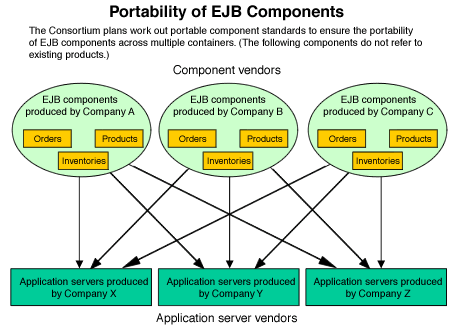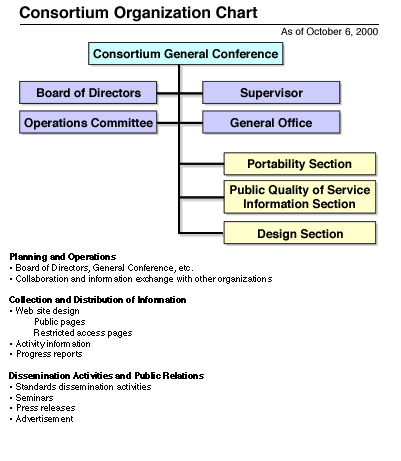
 |
 |

2000.09.20
EJB Components Consortium to be established in October; consortium members will work out portability standards for EJB compliant software components
EC-One, Inc.
NTT COMMUNICATIONWARE CORPORATION
Kawatetsu Systems, Inc.
IBM Japan, Ltd.
Hitachi Software Engineering Co., Ltd.
Fujitsu Ltd.
EC-One, Inc. ("EC-One"), NTT COMMUNICATIONWARE CORPORATION, Kawatetsu Systems, Inc. (KSD), IBM Japan, Ltd. (IBM), Hitachi Software Engineering Co., Ltd. (Hitachi Software), and Fujitsu Ltd. (Fujitsu) have reached a basic agreement to invite IT vendors and user companies to participate in a Consortium to ensure the portability ( *1 ) of software components compliant with EJB ( *2 ) specifications.
With the advent of EJB as the standard for business applications on servers, the six enterprises proposed on October 6, 2000, the establishment of a consortium for working out standards to materialize the portability of software components and release the standards to the public. President Yuji Matsuo of NTT COMMUNICATIONWARE CORPORATION was elected chairman of the Consortium.
*Portability: Portable software, which is compliant with unique standards, can run on various environments independent of a specific hardware, OS, or middleware.



Consortium Activities
1. By December, the Consortium will work out standards for portable components compliant with EJB specifications, capable of running on the servers of multiple vendors.
2. By April 2001, standards will be worked out for public information on the quality of services toward promoting component distribution.
3. Upon completion of these standards, activities will be conducted to promote the distribution of standard-compliant components.
Considering the recent industry trend for most popular application servers to be EJB-compliant, the next step is expected to be distribution of operational components on the application servers.
This can only occur after component developers have been presented with clear design guidelines to prevent misinterpretations of EJB specifications and minimize differences among vendors in their implementation. In addition, application developers (as component users) have demanded function and quality of service standards to guide the selection of components.
The Consortium's first task is to work out the standards for enhanced portability of components. The second is to work out standards of public information for the quality of EJB components and design guidelines toward disseminating and promoting distribution of the components.
Consortium standards will enable component developers to develop highly distributable components regardless of differences among EJB-based application servers.
For application developers, the availability of highly portable components with no difference among component vendors makes it possible to configure applications by combining components from different vendors, dramatically shortening the development cycle and attaining a high level of reliability. For corporate environments in general, individual application programs will be able to operate on multiple vendor environments, facilitating the configuration of applications across the multiple platforms of merged or joint venture enterprises.
It is believed that, by developing these standards in an open forum and appealing for their public adoption, the Consortium will encourage domestic and overseas component developers to generate standard-compliant products that better serve user convenience, and will contribute to the overall expansion of the application software industry.
For now, two partners, IBM and Fujitsu, will offer application servers for testing the components and drafts for testing procedures, including functional requirements for potential components. The Consortium will soon begin working out the component standards for other applications servers.
Glossary
*1 EJB (Enterprise JavaBeans)
EJB (Enterprise JavaBeans) are component specifications in the J2EE (Java2 Enterprise Edition) common platform system for Java-based server applications. In 1998, Sun Microsystems, Inc. of the U.S. announced the first public release of EJB Version 0.1 for materializing software segmentation. EJB-based software segmentation supports enterprise application development independent of a specific OS (operating system), database system, or application server.
[Trademarks]
EJB (Enterprise JavaBeans), Java, J2EE are trademarks of Sun Microsystems, Inc. in the U.S. and other countries.
Company Profile
[EC-One]
 |
 |
| 1. Company Name: |
EC-One, Inc.
|
| 2. Location: |
Head Office: Mita-kokusai Building 17F, 1-4-28 Mita, Minato-ku, Tokyo 108-0073
|
| 3. Representative: |
President Yukihiro Kayama
|
| 4. Founded: |
April 14, 1998
|
| 5. Business Activities: |
WebSIService Web system configuration and consultation, various Internet-related technology services, object-oriented application architecture development, IT commercialization consulting services; recommendation, development, localization, establishment of marketing channels and strategies for products and services related to new information technologies and related areas using Internet networking technology and built-in systems with software techniques.
|
| 6. Capital: |
¥262,45 million (as of March 31, 2000)
|
[NTT COMMUNICATIONWARE CORPORATION]
 |
 |
| 1. Company Name: |
NTT COMMUNICATIONWARE CORPORATION
|
| 2. Location: |
Head Office : Konan 1-9-1, Minato-ku, Tokyo 108-8019
|
| 3. Representative: |
President Yuji Matsuo
|
| 4. Founded: |
April 1, 1997
|
| 5. Business Activities: |
Development, manufacturing, marketing, operation, and maintenance of systems and software, data communication devices, invoicing and other outsourcing services, from consulting to outsourcing in support of IT management.
|
| 6. Capital: |
¥923.45 million (as of March 31, 2000)
|
[KSD]
 |
 |
| 1. Company Name: |
Kawatetsu Systems, Inc.
|
| 2. Location: |
Head Office: Minamisuna 2-36-11, Koto-ku, Tokyo, 136-8582
|
| 3. Representative: |
President Masashi Tomishima
|
| 4. Founded: |
September 1, 1983
|
| 5. Business Activities: |
Configuration, operation, and maintenance of computers and information systems; marketing of associated software and devices.
|
| 6. Capital: |
¥923.45 million (as of March 31, 2000)
|
[IBM]
 |
 |
| 1. Company Name: |
IBM Japan, Ltd.
|
| 2. Location: |
Head Office: Roppongi 3-2-12, Minato-ku, Tokyo 106-8711
|
| 3. Representative: |
President Takuma Ootoshi
|
| 4. Founded: |
June 17, 1937
|
| 5. Business Activities: |
Providing business solutions for customer needs through products and services, including data-processing systems, software, and communication systems.
|
| 6. Capital: |
¥135.3 billion (as of August 31, 2000)
|
[Hitachi Software]
 |
 |
| 1. Company Name: |
Hitachi Software Engineering Co., Ltd.
|
| 2. Location: |
Head Office: 6-81 Onoe-cho, Naka-ku, Yokohama-shi, 231-0015
|
| 3. Representative: |
Chairman Tsutomu Sato, President Hiroyuki Kanekiyo
|
| 4. Founded: |
September 21, 1970
|
| 5. Business Activities: |
Development and marketing of computer software, data processing devices and systems: providing data processiong service and data communication services
|
| 6. Capital: |
¥32.4 billion (as of August 31, 2000)
|
[Fujitsu]
 |
 |
| 1. Company Name: |
Fujitsu Ltd.
|
| 2. Location: |
Marunouchi 1-6-1, Chiyoda-ku, Tokyo, 100-8211
|
| 3. Representative: |
President Naoyuki Akikusa
|
| 4. Founded: |
June 20, 1935
|
| 5. Business Activities: |
Manufacturing, marketing and other services related to communication systems, data processing systems, and electronic devices
|
| 6. Capital: |
¥307.5 billion (as of August 31, 2000)
|


|
|
|
|

